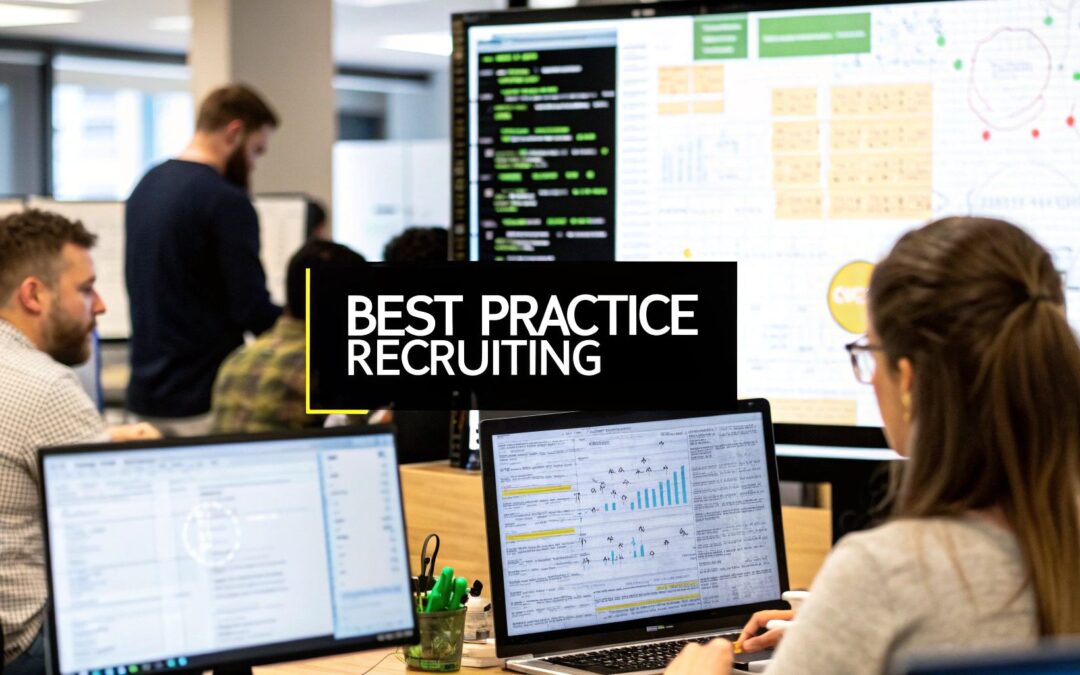In the competitive arena of tech startups and AI services, attracting top-tier talent is not just an HR function; it's a core business strategy that dictates the pace of innovation and growth. Outdated recruiting methods, focused on passive candidate screening and gut feelings, are no longer sufficient to build the high-performing teams needed to succeed. To build a team that can innovate, execute, and scale, organizations need a modern, strategic approach grounded in best practice recruiting.
This article cuts through the noise to deliver a definitive playbook of actionable strategies. We move beyond generic advice to provide seven essential frameworks you can implement immediately to refine your talent acquisition process. You will learn how to leverage data for smarter decisions, structure interviews to identify true potential, and build a compelling employer brand that attracts the right candidates organically. Whether you're scaling an AI startup or a global data services firm, these practices will form the foundation of a resilient and effective talent acquisition engine. This is your guide to finding, attracting, and hiring the innovators who will drive your company's future success.
1. Data-Driven Recruitment Analytics
The era of relying solely on intuition in hiring is over. Data-driven recruitment analytics is a systematic approach that applies data collection, analysis, and interpretation to the entire hiring process. This method transforms recruiting from a subjective art into a strategic science, enabling organizations to make informed, evidence-based decisions that align with business objectives. By tracking key metrics, you can pinpoint inefficiencies, enhance the candidate experience, and ultimately improve the quality of hire.
This practice involves establishing and monitoring key performance indicators (KPIs) across the recruitment funnel. Instead of guessing where problems lie, you can precisely identify bottlenecks, such as a high drop-off rate after the initial screening or an overly long time-to-hire for specific roles. This strategic overview is a cornerstone of modern best practice recruiting, allowing for continuous process improvement.

Why It's a Best Practice
Adopting a data-driven approach moves your hiring strategy from reactive to proactive. It helps you understand which sourcing channels yield the best candidates, which interview stages are most predictive of success, and how to allocate your recruitment budget for maximum ROI. Companies like Google pioneered this with their People Analytics teams, using predictive models to identify traits of successful hires and reduce bias. This methodology is particularly vital for tech startups and AI service providers, where securing top-tier talent is a critical competitive advantage.
Actionable Implementation Steps
To effectively integrate data-driven analytics into your recruitment, focus on a structured rollout:
- Start Small and Focused: Begin by tracking 3-5 core metrics. Good starting points include Time-to-Fill, Cost-per-Hire, Source-of-Hire, and Offer Acceptance Rate.
- Ensure Data Integrity: Standardize data entry across your Applicant Tracking System (ATS). Consistent and clean data is essential for generating reliable insights.
- Schedule Regular Reviews: Hold bi-weekly or monthly meetings with hiring teams to review the data. Discuss trends, identify problem areas, and brainstorm solutions together.
- Balance with Qualitative Feedback: Supplement quantitative data with qualitative insights from candidate surveys and hiring manager feedback. This provides context that numbers alone cannot. For a deeper dive into leveraging data for better outcomes, explore how to master data-driven decision-making for business growth.
2. Structured Behavioral Interviewing
Moving beyond gut-feel interviews, structured behavioral interviewing is a standardized methodology designed to assess job-relevant competencies. It operates on the well-researched principle that past behavior is the most reliable predictor of future performance. This technique uses a consistent set of predetermined questions, asking every candidate for a specific role to describe past experiences that demonstrate particular skills.
This approach requires candidates to provide detailed examples, often using the STAR method (Situation, Task, Action, Result) to frame their answers. By standardizing the questions and evaluation criteria, you create a more objective and equitable comparison between candidates. It is a cornerstone of best practice recruiting because it significantly reduces interviewer bias and increases the predictive validity of the hiring process.
Why It's a Best Practice
Structured behavioral interviewing elevates hiring from a casual conversation to a focused assessment of capability. This method is highly effective at uncovering how candidates have actually handled real-world challenges, rather than relying on hypothetical answers. Companies like Amazon have famously integrated this into their culture, using their Leadership Principles to frame behavioral questions and assess candidate fit. For tech and AI service providers, this is crucial for verifying critical competencies like problem-solving, collaboration, and adaptability under pressure, ensuring new hires can deliver results.
Actionable Implementation Steps
To successfully implement structured behavioral interviewing, a systematic approach is key:
- Develop Role-Specific Competency Models: Before writing questions, identify the core competencies (e.g., technical skills, teamwork, innovation) essential for success in each role. This forms the basis for your interview.
- Train Your Interviewers: Equip hiring managers with the skills to ask effective questions, use probing techniques for more detail, and avoid common biases. Consistent training ensures fairness across the board.
- Create a Question Bank: Build a library of behavioral questions tied to each competency. For a "Problem Solving" competency, a question could be: "Describe a complex technical problem you faced and the steps you took to resolve it."
- Use a Standardized Scorecard: Evaluate all candidates against the same predefined criteria and rating scale. Document specific examples from their answers to justify ratings, rather than just relying on a numeric score.
3. Employer Branding and Candidate Experience Optimization
In today's competitive talent market, the most skilled candidates have options. Employer branding is the strategic practice of defining and promoting your company's identity and reputation as an employer of choice. It is deeply intertwined with the candidate experience, which encompasses every interaction a potential hire has with your company, from the initial job ad to the final hiring decision. This approach recognizes that every candidate is also a potential customer and brand advocate.
This powerful combination ensures your organization not only attracts top talent but also provides a positive, transparent, and professional journey for every applicant. A strong employer brand acts as a magnet, while a superior candidate experience ensures those attracted candidates remain engaged and view your company favorably, regardless of the hiring outcome. This synergy is a vital component of modern best practice recruiting, transforming the process from a transactional function into a strategic branding opportunity.

Why It's a Best Practice
A deliberate focus on employer branding and candidate experience gives you a significant competitive edge. Companies like HubSpot and Salesforce have built powerful employer brands by showcasing their unique culture, values, and commitment to employee well-being, making them highly desirable places to work. This proactive strategy reduces reliance on outbound recruiting by creating a strong inbound flow of qualified applicants. For tech startups and AI service providers, where talent is the primary asset, a positive reputation can be the deciding factor for a candidate choosing your offer over a competitor's. A negative experience, on the other hand, can quickly damage your brand on platforms like Glassdoor and social media.
Actionable Implementation Steps
To effectively build your employer brand and optimize the candidate journey, integrate these focused actions:
- Audit and Define Your EVP: Start by defining your Employee Value Proposition (EVP). What makes your company a unique and compelling place to work? Survey current employees to gather authentic insights.
- Train Hiring Managers as Brand Ambassadors: Ensure everyone involved in the hiring process understands their role in representing the company's brand and values. Provide training on interview best practices and timely communication.
- Optimize Every Touchpoint: Review and streamline your application process, especially for mobile users. Ensure communication is prompt, respectful, and transparent at every stage. Understanding How to Improve Candidate Experience is a crucial first step.
- Gather and Act on Feedback: Regularly send out candidate experience surveys to both hired and rejected applicants. Use this feedback to identify pain points and make tangible improvements to your process.
4. Diversity, Equity, and Inclusion (DEI) Integration
Embedding diversity, equity, and inclusion (DEI) into recruitment is no longer a "nice-to-have" but a fundamental business imperative. This approach involves a comprehensive restructuring of the entire hiring process to actively dismantle systemic biases and ensure every candidate has an equal opportunity to succeed. It goes beyond tokenism to build genuinely diverse teams that drive innovation, creativity, and better problem-solving.
This practice requires moving from passive non-discrimination to active inclusion. It means re-evaluating everything from where you source candidates to how you write job descriptions and conduct interviews. True DEI integration is a core component of best practice recruiting, creating a talent pipeline that reflects the diverse world we live in and ultimately strengthening the organization's competitive edge.

Why It's a Best Practice
A proactive DEI strategy builds a more resilient, innovative, and high-performing workforce. Diverse teams consistently outperform homogeneous ones by bringing a wider range of perspectives and experiences to the table. Companies like Intel, which invested $300 million to achieve full representation, and Salesforce, known for its equal pay audits, have demonstrated that a commitment to DEI leads to tangible business results and a stronger employer brand. For tech startups and AI service providers, where a variety of viewpoints is crucial for developing unbiased algorithms and globally relevant products, an inclusive hiring process is non-negotiable.
Actionable Implementation Steps
To effectively integrate DEI into your recruitment strategy, focus on systematic changes rather than one-off initiatives:
- Revise Job Descriptions: Use inclusive language tools to scan and remove gender-coded or biased terminology from your job postings. Focus on skills and outcomes rather than an exhaustive list of qualifications that might deter diverse applicants.
- Implement Structured Interviews: Standardize interview questions for all candidates applying for the same role. This ensures every individual is evaluated against the same objective criteria, reducing the impact of unconscious bias.
- Establish Diverse Interview Panels: Ensure that interview panels include employees from different backgrounds, departments, and seniority levels. This provides a more balanced assessment and signals your commitment to inclusion to the candidate.
- Set Measurable Goals: Establish clear, measurable diversity goals for your hiring pipeline. Track metrics related to the diversity of your applicant pool at each stage and regularly review progress with hiring managers to ensure accountability. For more insights on building inclusive teams, you can explore resources from leading inclusion strategists like Vernā Myers.
5. AI-Powered Talent Acquisition
The strategic implementation of artificial intelligence is revolutionizing the recruitment landscape. AI-powered talent acquisition involves using machine learning and automation to streamline and enhance critical stages of the hiring process. This technology automates repetitive tasks like resume screening and interview scheduling, freeing up recruiters to focus on strategic relationship-building and complex decision-making, which is a key component of modern best practice recruiting.
By leveraging AI, organizations can source candidates more effectively, reduce unconscious bias, and accelerate the entire hiring cycle. Tools can analyze job descriptions and candidate profiles to predict success, while chatbots can engage applicants 24/7, providing instant responses and improving the candidate experience. This data-driven efficiency is crucial for tech startups and AI service providers competing for a limited pool of elite talent.
Why It's a Best Practice
Adopting AI in recruitment provides a significant competitive edge by increasing speed, precision, and fairness. It allows hiring teams to process vast volumes of applications quickly and identify top-tier candidates who might otherwise be overlooked. Companies like Unilever have successfully used AI-driven assessments to screen graduate applicants, resulting in a more diverse talent pool and a 75% reduction in time-to-hire. This approach transforms hiring from a manual, labor-intensive process into a highly optimized, strategic function.
Actionable Implementation Steps
To effectively integrate AI into your recruitment strategy without losing the human element, follow these steps:
- Start with One High-Impact Area: Begin by implementing an AI tool for a single, well-defined task, such as resume screening or interview scheduling. This allows you to measure impact and manage change effectively.
- Maintain Human Oversight: Ensure that AI systems are used to augment, not replace, human judgment. Keep recruiters involved in critical decision points like final interviews and offer extensions.
- Audit for Bias Regularly: Proactively review your AI tools and their algorithms to ensure they are not inadvertently perpetuating or creating biases. Partner with vendors who prioritize fairness and transparency.
- Be Transparent with Candidates: Inform applicants when they are interacting with an AI system, such as a chatbot or a gamified assessment. For a deeper dive into how AI can revolutionize your hiring, consider exploring a definitive guide to AI for talent acquisition. For businesses looking to build their own custom solutions, exploring low-code and no-code AI platforms can be a strategic starting point.
6. Strategic Talent Pipelining and Relationship Building
Reactive hiring, where the search for candidates begins only after a position opens, is inefficient and costly. Strategic talent pipelining is a proactive recruitment approach that involves building and nurturing relationships with potential candidates long before a specific hiring need arises. This method shifts recruiting from a transactional process to a continuous, relationship-driven function, ensuring a ready supply of qualified, engaged talent.
By creating curated talent pools for critical roles, you can significantly reduce time-to-hire and improve the quality of candidates. This forward-thinking strategy is a cornerstone of best practice recruiting, allowing organizations to stay ahead of hiring demands and build a competitive advantage. It’s about cultivating a community, not just a candidate database.
Why It's a Best Practice
Talent pipelining transforms your organization from a passive job advertiser into a destination for top talent. It allows you to engage with high-potential individuals, understand their career aspirations, and keep your company top-of-mind for when they are ready to make a move. For rapidly scaling tech startups and specialized AI service providers, having a warm pipeline of engineers, data scientists, or sales leaders is not just a benefit; it's a strategic necessity. Executive search firms have long used this methodology, and tech giants in Silicon Valley rely on it to secure scarce, high-demand talent.
Actionable Implementation Steps
To build an effective talent pipeline, you need a systematic and value-driven approach:
- Segment Your Talent Pools: Don't just create one large database. Segment potential candidates by skill set, experience level, and potential roles (e.g., "Future Senior AI Engineers" or "Potential Sales Directors").
- Use a Recruitment CRM: A dedicated Candidate Relationship Management (CRM) system is crucial for tracking interactions, scheduling follow-ups, and managing your talent community effectively.
- Provide Consistent Value: Nurture relationships by sharing valuable content, such as industry insights, company news, or invitations to exclusive webinars. The goal is to build rapport, not to constantly pitch jobs.
- Align with Business Forecasting: Work closely with department heads to understand future hiring needs and strategic growth plans. This ensures your pipelining efforts are focused on the most critical future roles. To further enhance efficiency, explore how automating recruitment workflows can streamline your process.
7. Skills-Based Hiring and Competency Assessment
Skills-based hiring is a methodology that prioritizes a candidate's demonstrable abilities and competencies over traditional credentials like degrees or years of experience. This modern approach uses practical assessments, work samples, and skill-based evaluations to predict on-the-job performance with greater accuracy. It effectively widens the talent pool by creating opportunities for skilled individuals from non-traditional backgrounds.
This practice shifts the focus from where a candidate learned something to what they can actually do. By evaluating core competencies directly, organizations can identify high-potential talent that might be overlooked by resume-screening algorithms focused on pedigree. This shift is a key component of effective best practice recruiting, as it aligns hiring decisions directly with the practical needs of the role.
Why It's a Best Practice
Adopting skills-based hiring reduces bias and increases diversity, as it evaluates candidates on objective, job-relevant criteria rather than proxies for skill. It also leads to a higher quality of hire because the selection process is a direct simulation of the job's demands. Tech giants like Google and IBM have successfully implemented this by removing degree requirements for many roles, focusing instead on a candidate's ability to solve real-world problems. For AI and data service providers, this method is invaluable for identifying talent with niche technical skills that formal education may not yet cover.
Actionable Implementation Steps
To effectively transition to a skills-based hiring model, follow these strategic steps:
- Deconstruct Job Roles: Break down each position into a set of core competencies and required skills. Clearly define what "good" looks like for each skill.
- Develop Job-Relevant Assessments: Create practical tests that mirror the tasks the employee will perform. For a software engineer, this could be a coding challenge; for a data annotator, a sample annotation project.
- Train Hiring Managers: Equip your interviewers to evaluate candidates based on demonstrated competencies, not just their resume or interview rapport. Provide structured interview guides and scoring rubrics.
- Use Multiple Assessment Methods: Combine different evaluation types, such as technical tests, case studies, and behavioral interviews, for a comprehensive and valid assessment of a candidate’s abilities. For more on creating effective job requirements, you can explore guides on how to write a job description.
Best Practices Recruiting: 7-Point Strategy Comparison
| Approach | Implementation Complexity 🔄 | Resource Requirements ⚡ | Expected Outcomes 📊 | Ideal Use Cases 💡 | Key Advantages ⭐ |
|---|---|---|---|---|---|
| Data-Driven Recruitment Analytics | High — requires tools, training, data processes | Significant upfront investment | Improved hiring ROI, reduced bias, optimized recruitment funnel | Organizations seeking evidence-based hiring and process optimization | Reduces bias, continuous improvement, clear pipeline visibility |
| Structured Behavioral Interviewing | Medium-High — training and standardized design | Training-intensive, time-consuming | Reliable, valid candidate assessments predicting job success | Roles needing competency-based evaluation and legal defensibility | Reduces interviewer bias, fair comparisons, legal compliance |
| Employer Branding & Candidate Experience | Medium — cross-departmental coordination needed | Long-term investment, marketing resources | Enhanced employer reputation, better candidate attraction | Companies focusing on talent attraction and positive candidate journeys | Attracts quality candidates, reduces time/cost to fill, boosts referrals |
| Diversity, Equity & Inclusion Integration | High — cultural/process change, ongoing effort | Training, audits, diverse sourcing efforts | More diverse, innovative teams with reduced bias and risk | Organizations committed to equitable hiring and inclusive culture | Improves innovation, expands talent pools, reduces legal risks |
| AI-Powered Talent Acquisition | High — technical implementation, data needs | High costs, ongoing maintenance | Faster hiring, scalable application processing, reduced bias | Large volume hiring, global recruitment, efficiency drives | Dramatically speeds processes, 24/7 operation, data-driven insights |
| Strategic Talent Pipelining & Relationships | Medium-High — sustained engagement, CRM tools | Ongoing resource-intensive relationship management | Reduced time-to-hire, access to passive candidates | Companies with long-term talent needs and competitive markets | Builds pipelines, improves candidate quality, enables workforce planning |
| Skills-Based Hiring & Competency Assessment | Medium — assessment development and validation | Development of assessments, training | Better job performance prediction, increased diversity | Roles where skills demonstrate success, non-traditional candidate sourcing | Predicts job fit better, reduces bias, opens talent pool beyond credentials |
Building Your Talent Engine for Tomorrow
Navigating the competitive landscape of tech and AI requires more than just a great product; it demands an exceptional team. The journey to building that team is a strategic endeavor, not a series of disconnected hires. Implementing best practice recruiting is the framework for constructing a sustainable, high-performance talent engine that powers your organization's growth and innovation.
Throughout this guide, we've explored seven critical pillars that form the foundation of a modern, effective hiring strategy. From harnessing the predictive power of data-driven recruitment analytics to ensuring fairness and consistency through structured behavioral interviewing, each practice serves a distinct purpose. By meticulously crafting your employer brand and optimizing the candidate experience, you don't just fill roles; you attract advocates. Integrating DEI principles into every stage of the funnel expands your talent pool and fosters a more innovative culture.
Furthermore, leveraging AI-powered tools automates repetitive tasks, allowing your team to focus on human connection. Proactive talent pipelining ensures you're never starting from scratch when a critical role opens, while a commitment to skills-based hiring prioritizes true capability over traditional credentials.
Turning Insights into Actionable Strategy
The key takeaway is that these practices are not a checklist to be completed but a system to be integrated. They are interconnected components of a single, powerful machine. A strong employer brand attracts a diverse pipeline, structured interviews help assess skills-based competencies fairly, and data analytics provide the insights needed to refine every part of the process.
To begin transforming your approach, don't try to implement everything at once. Instead, identify your most significant bottleneck and start there:
- If you struggle with inconsistent interview feedback, begin by implementing a structured behavioral interviewing framework for a single, high-priority role.
- If your candidate pipeline is sparse, focus your initial efforts on strategic talent pipelining and enhancing your employer branding content.
- If you need to improve efficiency, explore AI-powered sourcing tools to automate top-of-funnel activities and free up recruiter time for meaningful candidate engagement.
By adopting an iterative approach, you can build momentum and demonstrate value, making it easier to gain buy-in for broader changes. Mastering this holistic approach to best practice recruiting transforms your talent acquisition function from a reactive cost center into a proactive, strategic advantage. You will not only hire faster and more effectively but also attract and retain the kind of talent that becomes the driving force behind your company's most significant breakthroughs.
Ready to accelerate your team's capabilities without the lengthy hiring cycles? For specialized roles in data annotation, transcription, and multilingual services, Zilo AI provides access to a pre-vetted, global workforce skilled in powering complex AI and data projects. Partner with Zilo AI to seamlessly integrate top-tier talent and scale your operations on demand.

